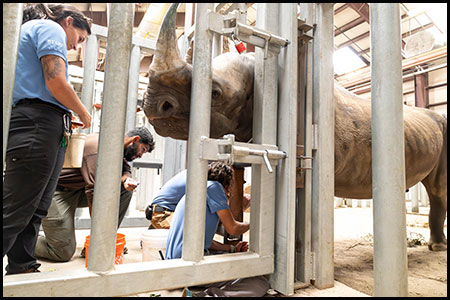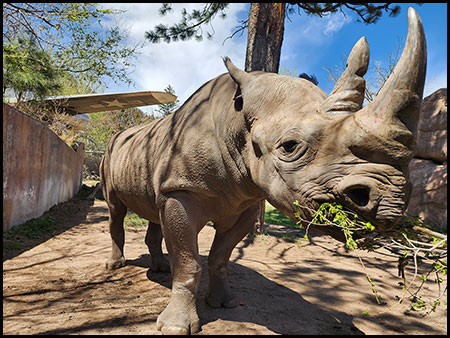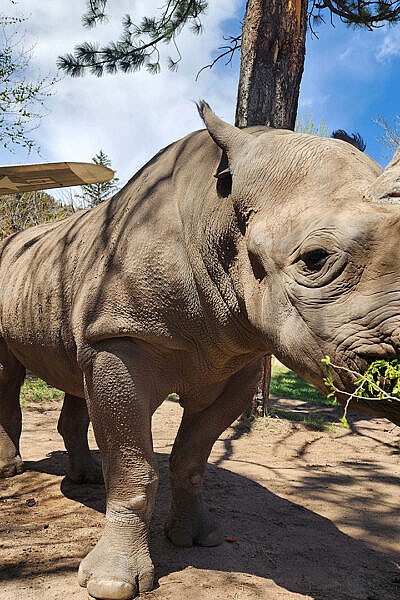Jumbe, a 21-year-old Eastern black rhino at Cheyenne Mountain Zoo, continues to navigate a significant health challenge with the support of his care and veterinary teams. In May, a blood test revealed concerning iron saturation levels indicating a condition known as iron overload disorder.

Despite the diagnosis, Jumbe remains in good spirits. He consistently interacts with his keepers, participates in training and daily guest feedings, and shows no clinical signs of discomfort. His liver and kidney levels, along with other critical markers, are being closely monitored and remain within normal ranges.
This ailment is well documented among black rhinos in human care, affecting about one-third of the population. However, treatment options and results are limited. Iron overload can lead to serious health issues, potentially damaging vital organs and posing a risk of fatal complications over time.
Black rhinos are particularly susceptible to iron overload due to their unique metabolic processes. Knowing this, Jumbe’s care team has always tailored his diet to minimize iron absorption. Following his diagnosis, they made further adjustments to Jumbe’s diet, with support from the Black Rhino Nutrition Advisory Group.
By June, follow-up bloodwork showed a 10 percent improvement in Jumbe’s iron levels. But, his most recent results, in early August, revealed a return to the original high levels. Unfortunately, diet controls alone don’t seem to be working for Jumbe.
So, Jumbe’s care team is focused on voluntary large-volume blood draws as a supplementary treatment, while continuing diet controls. Phlebotomy isn’t new to Jumbe or his team. He has long been an expert in voluntary blood draw behaviors.
“This is a great example of why it’s so important to establish trained voluntary behaviors before you need to rely on them,” Ilana Cobban, Encounter Africa animal care manager says. “He has been blood-draw trained for many years, so he’s comfortable and confident with the setup. When he was first diagnosed, we started increasing the frequency of his blood draw training sessions. Since mid-August, we’ve been successfully drawing large volumes of blood weekly, and Jumbe has been adjusting amazingly.”
During large-volume blood draws, the team aims to collect at least 100 milliliters (mLs)
or about 3.5 fluid ounces per session, in a carefully controlled manner. The team has to be precise with the needle and acutely tuned-in to Jumbe’s behaviors for each session to be successful. They draw multiple vials of blood during a session, but limit themselves to one needle insertion for Jumbe’s comfort. It takes three keepers, meticulous coordination and a lot of Jumbe-specific knowledge.

“We have a trainer, a ‘brusher’ and a ‘mechanic’ during the blood draws,” Ilana says. “The trainer stands at Jumbe’s head, giving him training cues and reinforcing his participation with yummy snacks. They also watch Jumbe’s face and upper body for any behaviors – like a twitch – that might indicate we need to finish soon. The brusher is at Jumbe’s feet with the mechanic, brushing his opposite front leg, so he has a familiar and positive sensation, and a distraction from the sensation of the blood draw. The mechanic does the blood draw from underneath a metal port where Jumbe rests his chin. The three of us are constantly communicating with each other and with Jumbe about what’s happening now and what’s happening next.”
The median life expectancy for Eastern black rhinos in human care, according to the Association of Zoos and Aquariums, is 19 years, and Jumbe is 21. The team remains cautiously optimistic, exploring every possible avenue to support his health and well-being.
“We want to give Jumbe every chance to live a long, comfortable and fulfilling life,” Ilana says. “Because this treatment requires his voluntary participation, we will know if he doesn’t want to participate in a session. With a disease like this, we know it could take a turn at any moment, but for now, he’s enjoying life, and we’re determined to help him in the best ways possible.”
Guests can visit Jumbe in Encounter Africa, and participate in paid rhino feedings daily at noon through September. In October, feedings will be available on Saturdays and Sundays, weather permitting. These feeding opportunities give people a rare chance to hand-feed a rhino, and their payment supports the Zoo’s frontline black rhino and African elephant conservation partner, Tsavo Trust, in Kenya.

